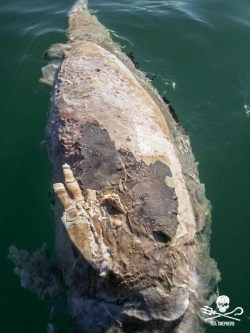Sea Shepherd Discovers Dead Vaquita Caught in Gillnet
Published by Sea Shepherd Conservation Society
The vaquita, one of the last specimens of the most endangered marine mammal in the world, was trapped in a net inside the Vaquita Refuge attesting that illegal gillnets are the biggest threat to the tiny cetacean.
San Felipe, Mexico – March 14, 2019 – On the morning of March 12th, 2019 Sea Shepherd ships M/V Farley Mowat and M/V Sharpie were on routine patrol in the Vaquita Refuge searching for illegal gillnets when they found a target. At that moment, net removal was not a possibility due to sea and weather conditions.
As per usual procedure, the Sea Shepherd crew recorded the location and returned to remove the illegal fishing gear when sea state allowed. The crew of Sea Shepherd’s M/V Farley Mowat started removing the illegal gillnet at 3 pm. Wildlife was trapped in the net, and as the crew was pulling it in they found an unidentified white animal. Some assumed it to be a totoaba fish.
The totoaba fish is the target species for the illegal gillnets that threaten the vaquita porpoise with imminent extinction. The two animals are of a very similar size, endemic to the Upper Gulf of California, and critically endangered. Their size and habitat likeness make the gillnets set to catch the totoaba the perfect death trap for the last vaquitas on earth. Totoabas are being caught to supply a lucrative black market of their swim bladders, which are sold as “medicinal” soup in Asia. The endangered fish is killed for less than 5% of its body. The rest is then discarded and left to rot.
 The unidentified animal was clearly dead, as the crew was reeling the net into the Sea Shepherd ship it fell off and into the ocean. The Sea Shepherd drone was launched in an attempt to identify the species before it floated away. The animal was too decomposed,
The unidentified animal was clearly dead, as the crew was reeling the net into the Sea Shepherd ship it fell off and into the ocean. The Sea Shepherd drone was launched in an attempt to identify the species before it floated away. The animal was too decomposed, and the fluke and head were missing, but crew believed it looked like a vaquita porpoise. Captain Octavio Carranza then deployed the small boat team and Sea Shepherd scientist Laura Sánchez in a further effort to identify the animal.
“The state of decomposition of the body of the cetacean was too advanced for us to be able to identify it,” said scientist Laura Sánchez. “The absence of the cranium further hampered the situation,” she finished.
After sending preliminary photographs to marine mammal experts and Sea Shepherd scientific advisers, it was determined that morphology and length matched the body of a vaquita porpoise. Genetic analysis is needed to confirm the identity of species.
Sea Shepherd transported the possible vaquita corpse to San Felipe, where it was given to government authorities for identification.
Sea Shepherd is working in close cooperation with Mexican governmental agencies such as the Environmental Secretariat (SEMARNAT), Navy (SEMAR), Fisheries Department (CONAPESCA), Federal Attorney’s Office for Environmental Protection (PROFEPA), and the National Commission of Protected Areas (CONANP) to ensure urgent measures are undertaken to protect the vaquita.
Recently there have been rumors spread in the Upper Gulf of California area that gillnets are not a threat to vaquitas and other cetaceans, inciting demands to the Mexican government.
Sea Shepherd has been present in the Upper Gulf of California since 2015 as part of Operation Milagro. In that time, the crew has documented the entanglement of 36 marine mammals trapped in illegal gillnets. Nine of them were cetaceans, only one of which was able to be saved – a juvenile humpback whale in early 2016.
Although Sea Shepherd has found several dead vaquitas confirmed by scientists to have been killed from entanglement, this is the first time one has been discovered still trapped in a gillnet.
“If there were any reservations about totoaba gillnets being a great danger for vaquitas and other cetaceans, despite ample proof in the past, this event should definitely leave no room for doubt,” said Sea Shepherd Director of Marine Operations Locky Maclean.
Read the full article at: https://seashepherd.org/2019/03/14/sea-shepherd-discovers-dead-vaquita-caught-in-gillnet/












